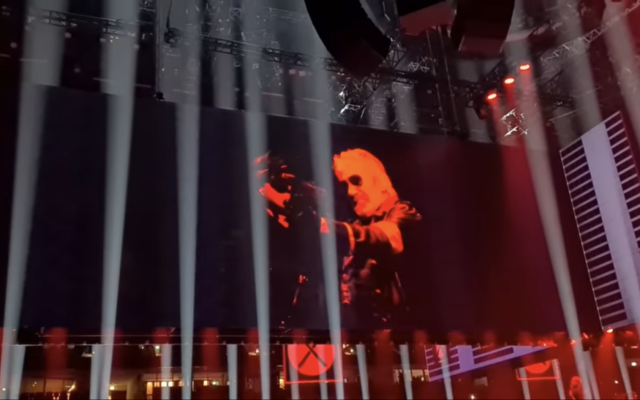I think it’s safe to say that everyone knows — or has at least heard of — the iconic song, “Another Brick in the Wall Part 2″(yes, that’s what it’s officially called, because there’s a part 1 and a part 3 as well). OK, I’m exaggerating, not everyone knows the song, but that’s what it seemed like when I was kid. After Pink Floyd’s double album The Wall was released in 1979, it became an anthem for schoolchildren all over the world to sing in supposed rebellion against their strict and very mean teachers. I remember being in 4th or 5th grade, outside in the schoolyard at recess, and in unison with the rest of my class, chanting “We don’t need no education, we don’t need no thought control”, and then “Hey, teacher, leave us kids alone!” and laughing hysterically. Even as an 11-year-old, I knew the words to that song and every other song on the album. I loved listening to The Wall, not understanding in the least bit what any of the words meant or were trying to tell us. Was there dark symbolism there? I didn’t know or care. The music was great and the lyrics were easy to remember. If there was a message there, I didn’t get it.
The movie version of The Wall came out in theaters in 1982, one of the not-so-common occasions where a feature film is produced based on an album, and not the other way around. I did not see it in the theater of course, as it was rated R (for good reason), but I did watch it several years later on video. I admit that I was shocked when I saw the songs I had been listening to for years played out on the big screen (or small screen, in my case). I learned that the film was apparently semi-autobiographical, with many references to lead vocalist Roger Waters’ own childhood traumas, combined with former bandmate Syd Barrett’s struggles with mental illness and drug use. I could see that this story, or rather, biopic, was something much more symbolic — and sinister — than I had previously known.
Here is a very brief synopsis of the plot:
Pink is a successful yet deeply troubled rock star. His soldier father was killed in WWII, when Pink was a baby, and he grew up in England as an only child with a paranoid and overbearing mother, ruthless teachers and oppressive headmasters who humiliated him in school. Though he now has a successful music career, he has destructive relationships with nearly everyone in his life, and he is clearly living with (what today we call) PTSD. He uses drugs to help him cope with life, which of course just exacerbate his problems. His wife deserts him as he falls into a deep depression, hallucinating and remembering all the negative things in his life that have brought him to where he is today. Much of the film is shown in flashbacks, with music and songs taking the place of dialogue for most of the movie. Pink begins to unravel, allowing an imaginary wall to be built around him with the bricks representing every traumatic thought and experience in his life. He alienates everyone and self-isolates. After a particularly violent, drug-induced episode, his band manager finds Pink semi-conscious right before he is about to perform, and injects him with something to wake him up. And wake up he does. He starts hallucinating wildly, imagining himself morphing into a fascist neo-Nazi skinhead-complete with eery Nazi-like imagery: red armbands with two claw hammers crossed (reminiscent of the swastika), black boots, and army uniforms. His “concert” has now turned into a neo-Nazi rally. Pink screams to a stadium filled with faceless followers (very much like Nazi Germany) and proceeds to blame Jews, blacks, and gay people for bringing troubles to the world and ultimately causing war. After all, war killed his father for no good reason and brought him to the miserable life that he leads today. So he decides to blame the victims. Sound familiar?
Of course, the movie is supposed to be depicting the evils of fascism. The film was meant to be metaphorical, showing how too much governmental control causes the downfall of a society of free thinkers. How our civil liberties are taken away without even realizing it. How people who are controlled become clones of one another and ultimately become faceless robots. How society becomes disenfranchised and the people revolt. War ensues, there is mass destruction and despair, and then the next generation picks up the pieces and the cycle starts again. And blah blah blah.
Fast forward to 2023, and the world now knows that Roger Waters is a rabid antisemite, BDS proponent, pro-Palestinian activist who is notorious for trying to persuade musicians scheduled to perform in Israel to cancel their concerts. He creates videos where he spews old anti-Jewish tropes while wearing a kefiyah as a scarf. He often looks disheveled and sounds like a madman. Yet, he is still on tour, performing in Germany, of all places. Although Waters left Pink Floyd back in 1985, he has continued to perform their music, complete with elaborate stage sets and special effects. The Germany shows were no exception. A few German cities attempted to prevent Waters from performing, but his concerts in Berlin and Frankfurt went ahead as planned. And the beast behind the music showed his true colors, as was expected. As he performed songs from The Wall, he was dressed as Pink in his neo-Nazi manic state, aiming his imitation machine gun at the audience.
Was this just part of the show? Was Roger Waters merely playing the part of Pink, or….has he actually become Pink? I think we can all now agree that “the worms ate into his brain” (IYKYK). Roger Waters has become that neo-Nazi. It’s official: Waters’ “masterpiece” of 1979 has sadly become a self-fulfilled prophecy.
Postscript: I now know how sick and demented Roger Waters’ music was, and I am disgusted when I am out and about and hear one of Pink Floyd’s (pre-1985) songs come on. But like I said, I grew up listening to them, and like many other Jewish kids from GenX, I didn’t know there was anything amiss. I would put on those enormous 1980s stereo headphones and listen for hours to Pink Floyd, as well as other popular rock bands such as The Boomtown Rats, The Cars, The Who, Talking Heads, The Kinks, David Bowie, etc. (Thanks to my two very cool older sisters who had great taste in music! Shout-out to them if they are reading this). I certainly never thought about any evil intent the lead singer of a band may have had. Did anyone? Had I known then what I know now…
Interesting Fact: Though Roger Waters wrote the screenplay for The Wall, he did not star in or sing in the movie at all, and the lead role was given to The Boomtown Rats’ frontman Bob Geldof, who portrayed the fictional protagonist “Pink”. (Remember Bob Geldof? He organized the 1985 Live Aid concert. He is also the one who sang I Don’t Like Mondays, about a 16-year old girl who, in 1979, shot up the elementary school across the street from her house in San Diego with a .22 semi-automatic rifle that her father had given her. When asked by a reporter why she did it, she replied “I don’t like Mondays. This livens up the day”.)
Chana Resnick Pinto made aliya from Toronto in 2005 with her family and has lived in the Sharon area of Central Israel ever since. She earned a BA from Yeshiva University and an MSEd from Bank Street College of Education in New York City. Chana works at Eric Cohen Books in Ra'anana and loves living in Israel. She encourages everyone to stop and smell the flowers and always appreciate the small things.




